Solar eclipse of June 28, 1889
An annular solar eclipse occurred on June 28, 1889. A solar eclipse occurs when the Moon passes between Earth and the Sun, thereby totally or partly obscuring the image of the Sun for a viewer on Earth. An annular solar eclipse occurs when the Moon's apparent diameter is smaller than the Sun's, blocking most of the Sun's light and causing the Sun to look like an annulus (ring). An annular eclipse appears as a partial eclipse over a region of the Earth thousands of kilometres wide. The path of annularity crossed Atlantic Ocean, Africa and Indian Ocean. This was the 47th solar eclipse of Solar Saros 125. The Sun was 95% covered in a moderate annular eclipse, lasting 7 minutes and 22 seconds and covering a broad path up to 232 km wide.
| Solar eclipse of June 28, 1889 | |
|---|---|
 Map | |
| Type of eclipse | |
| Nature | Annular |
| Gamma | -0.5431 |
| Magnitude | 0.9471 |
| Maximum eclipse | |
| Duration | 442 sec (7 m 22 s) |
| Coordinates | 9.6°S 47.3°E |
| Max. width of band | 232 km (144 mi) |
| Times (UTC) | |
| Greatest eclipse | 9:00:00 |
| References | |
| Saros | 125 (47 of 73) |
| Catalog # (SE5000) | 9256 |
Related eclipses
It is a part of solar Saros 125.
The last seven annular solar eclipses of Solar Saros 125 without a penumbra southern limit (six after 1889)
Part 1 of 2
| June 28, 1889 | July 10, 1907 | July 20, 1925 |
|---|---|---|
 |
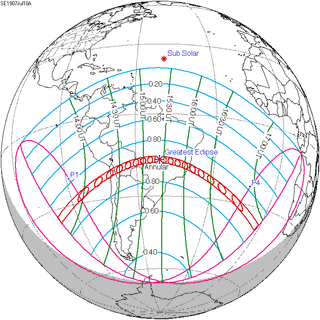 |
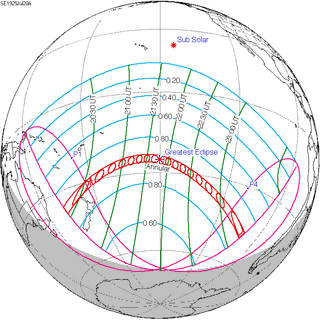 |
Part 2 of 2
| August 1, 1943 | August 11, 1961 | August 22, 1979 |
|---|---|---|
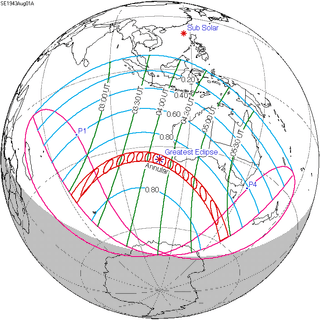 |
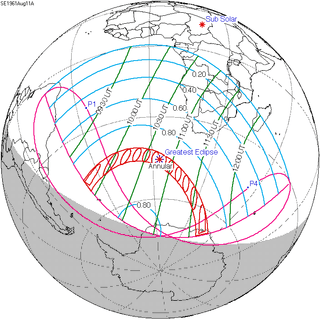 |
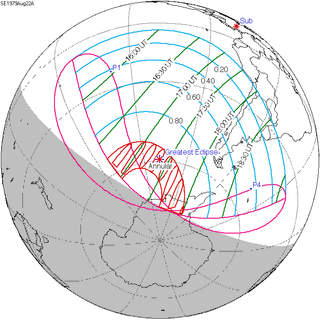 |
Saros 125
Solar saros 125, repeating every about 18 years and 11 days, contains 73 events. The series started with a partial solar eclipse on February 4, 1060. It has total eclipses from June 13, 1276, to July 16, 1330. It has hybrid eclipses on July 26, 1348, and August 7, 1366, and annular eclipses from August 17, 1384, to August 22, 1979. The series ends at member 73 as a partial eclipse on April 9, 2358. The longest total eclipse occurred on June 25, 1294, at 1 minute and 11 seconds; the longest annular eclipse occurred on July 10, 1907, at 7 minutes and 23 seconds.[1]
| Series members 47–58 occur between 1881 and 2100: | ||
|---|---|---|
| 47 | 48 | 49 |
 June 28, 1889 |
 July 10, 1907 |
 July 20, 1925 |
| 50 | 51 | 52 |
 August 1, 1943 |
 August 11, 1961 |
 August 22, 1979 |
| 53 | 54 | 55 |
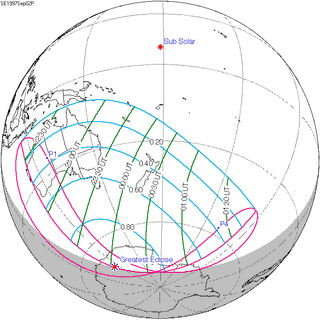 September 2, 1997 |
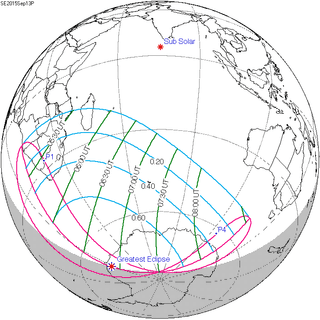 September 13, 2015 |
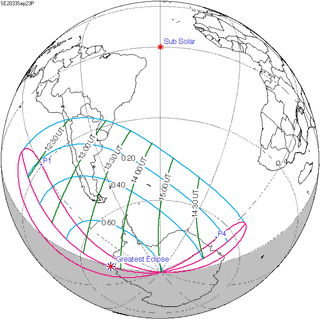 September 23, 2033 |
| 56 | 57 | 58 |
 October 4, 2051 |
 October 15, 2069 |
 October 26, 2087 |
Notes
- Saros Series Catalog of Solar Eclipses NASA Eclipse Web Site.
.jpg)
